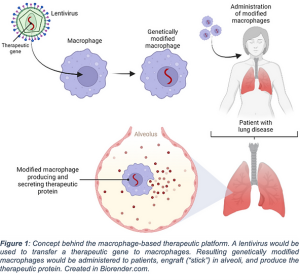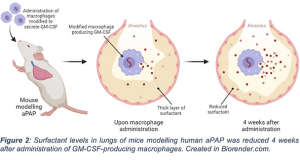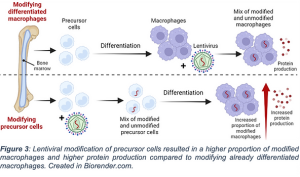By Leoma Bere A new and improved method of cell therapy has shown promising early…

Genetically Modified Macrophages: A Treatment for Multiple Lung Diseases?
Author: Victoria Ruth Richardson
Lung diseases are a significant burden to human health globally, with around a third of deaths worldwide resulting from chronic respiratory diseases(1). The complex nature of the lungs means they can be afflicted by numerous conditions such as asthma, chronic obstructive pulmonary disease (COPD), cystic fibrosis (CF), and autoimmune pulmonary alveolar proteinosis (aPAP). These diseases require numerous therapies, yet treatments can be ineffective and resources for developing new therapies are often stretched. But what if there was a way to successfully treat all these conditions and more with the same therapy?
Enter the macrophage.
Macrophages are a cell type present in almost all tissues of the body and are extremely adaptable cells that carry out many roles, ranging from immune functions to functions in wound healing and metabolism(2). Given their adaptability and presence in the lungs, macrophages are the focus of a novel method to treat respiratory diseases. This method uses a macrophage-based therapeutic platform, in which modified macrophages (the platform) can be reused and adapted to treat multiple lung diseases, similar to how the same foundations can be used to build different houses.
The idea behind this platform is that macrophages genetically modified outside of the body can be administered to patients and will “stick” in the lungs in tiny balloon-like air sacs known as alveoli. These modified macrophages would act as factories, producing and secreting a protein that would treat the patient’s disease (Figure 1). For example, macrophages producing anti-inflammatory proteins could treat asthma and COPD.
At present, this platform has been tested using mouse macrophages, with work by Clarke and colleagues as yet unpublished but presented at scientific conferences(3,4). In this work, it has been shown that macrophages that have differentiated (developed from immature cells into macrophages) from bone marrow can be modified using a lentivirus. This is a specific type of virus that introduces the gene producing the therapeutic protein into macrophage DNA, meaning this gene will be passed onto new cells when modified macrophages divide; this is important for long-lasting protein production.
Clarke has likewise demonstrated that macrophages can successfully treat mice that model the human disease aPAP(4). aPAP is a rare disease where surfactant, a fluid normally present as a thin layer in the alveoli to aid breathing, builds up to abnormal levels; if the lungs were a sink, surfactant build-up is like having a blocked drain that inhibits the flow of water (or in the lungs, air) through the system. When macrophages modified to produce the protein GM-CSF (granulocyte-macrophage colony-stimulating factor) were administered to mice mimicking human aPAP symptoms, these macrophages remained in the lungs and improved surfactant clearance for up to 4 weeks (Figure 2). In other words, the modified macrophages unblocked the drain.
So the platform works, but how can it be improved?


Macrophages are a difficult cell type to modify as they have an in-built defence system against viruses – essentially, they have a burglar alarm that will sound when lentiviruses are trying to enter the cell, and this reduces the proportion of macrophages that will be successfully modified with each lentivirus exposure. Recent work has focused on trying to increase the proportion of macrophages successfully being modified, with the goal of increasing overall therapeutic protein production. As mentioned above, macrophages for this platform differentiate from bone marrow which contains precursor cells that will develop into macrophages when subjected to the right conditions. Modification of precursor cells was found to increase the proportion of resultant modified macrophages and increase protein production compared to when modification happened after cells had already differentiated into macrophages (Figure 3). A possible explanation for this is that the precursor cells lack a mature defence system – they haven’t properly set-up their burglar alarm, enabling viruses to enter cells more frequently. Modifying precursor cells may therefore be one way to improve platform efficiency.
The work described above suggests that modified macrophages could be used as a therapy to treat multiple lung diseases. However, not only does more work need to be done to increase platform efficiency, but specific proteins that could be used to treat diseases like asthma, COPD, and CF need to be identified. Testing in mice and larger mammals modelling each disease would then be required before translation to humans could occur.
The road leading to human treatment with this macrophage-based therapeutic platform is a long and potentially winding one. However, the promise of using modified macrophages to treat multiple lung diseases means that pursuing this therapy may be very much worthwhile to scientists and patients alike.

References
1. GBD Chronic Respiratory Disease Collaborators. Prevalence and attributable health burden of chronic respiratory diseases, 1990-2017: a systematic analysis for the Global Burden of Disease Study 2017. The Lancet Respiratory Medicine. 2020; 8(6): 585-596. doi:10.1016/S2213-2600(20)30105-3.
2. Anderson NR, Minutolo NG, Gill S and Klichinsky M. Macrophage-Based Approaches for Cancer Immunotherapy. Cancer Research. 2021; 81(5): 1201-1208. doi:10.1158/0008-5472.can-20-2990.
3. Clarke N, Sinadinos A, Meng C, Alton E and Griesenbach U. 2021, Ex vivo transduced macrophages produce therapeutic levels of secreted protein when transplanted to the lung. ESGCT Collaborative Virtual Congress. Publisher: Mary Ann Liebert, ISSN: 1043-0342.
4. Clarke NK, Sergijenko A, Pineault K, Sinadinos A, Meng C, Griesenbach U, et al. 2022, Ex Vivo Transduced Macrophages Engraft in the Lung Following Transplantation and Produce Therapeutic Levels of Secreted Proteins, American Society of Cell and Gene Therapy. Publisher: CELL PRESS, Pages: 405-405, ISSN: 1525-0016.

